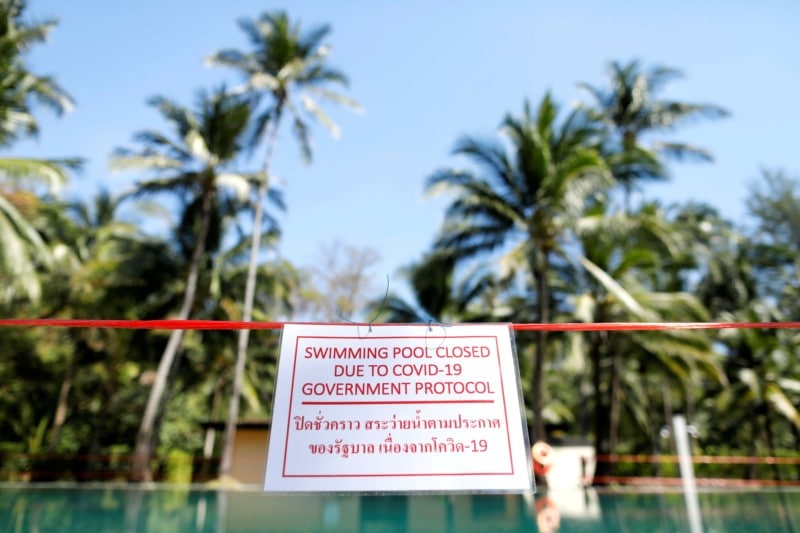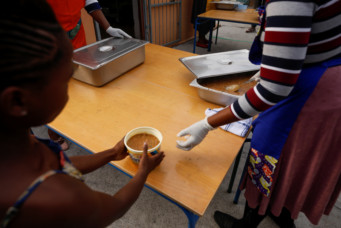Global Tourism Post COVID-19 and the Island Model
A recovery in tourism, one of the hardest hit industries by the COVID-19 pandemic, is inevitably tied to health considerations. It also depends on governments’ willingness to move away from old models toward long-term sustainability.

A hotel swimming pool is seen closed due to the COVID-19 pandemic in Trat province, Koh Chang island, Thailand, Jan. 10, 2021. Jorge Silva/Reuters
The COVID-19 pandemic has severely restricted mobility on the national and global levels. The tourism industry has been one of the hardest hit by national lockdowns, travel restrictions, and the general sense of fear and uncertainty about the current and future situation. The economic effects of this are severe; according to a report by the International Monetary Fund (IMF), tourism, directly and indirectly, contributes a formidable 10 percent of global GDP. Clearly, it would not be an exaggeration to say that any blow to tourism would be felt by the economic system in its entirety.
Coinciding with the release of the aforementioned report, the IMF hosted a webinar on “Tourism in the Post-Pandemic World,” Deputy Managing Director at the IMF Antoinette Monsio Sayeh opened the discussion by recognizing the role of tourism as a “significant driver of economic activity around the world”.
While some countries have focused primarily on getting domestic tourism back on track, Sayeh believes that “a real recovery will only be possible when international tourism returns”. For that to happen, global cooperation on equitable vaccine distribution is needed (almost 70 percent of vaccinations occurred in the world’s fiftieth richest countries compared to 0.1 percent in the poorest) and special attention to health and hygiene protocols in order to safely lift travel restrictions.
In the long-term, the crisis is an opportunity to promote structural transformation within and beyond the tourism sector, Sayed added, putting greater focus on low density, eco-sustainable practices and the strengthening of health systems by “leveraging technological innovation to ensure protection of tourists and workers”. On that, Trevor Weltman, a partner at the Asia office of the Clickable Impact Consulting Group, stressed the importance of looking at the informal nature of large parts of the tourism industry. He believes that this health crisis has evolved into an economic and social crisis which is acutely felt in tourism due to the relative informality of the sector. Weltman gave the example of Thailand, where tourism accounts for 12 percent of GDP, is projected to have lost six million jobs in 2020 due to COVID-19, with a recovery in tourism not coming until the second quarter of 2022—even if the country achieves the 50 percent immunization rate it is aiming for.
The Health Dimension
The main challenge for a full recovery in tourism stems from the fact that any recovery is inextricably linked to immunization; for enough tourists to feel safe enough to freely travel, either they or everyone around them must be immune to the virus. And for governments to feel confident enough to re-open all their borders, facilities, and services to the global public, there must be a certain degree of immunity in the local population or a guarantee that incoming tourists are immune.
While the latter is at present functionally a PCR test, it does not serve as a guarantee that a tourist will not contract and further spread the virus to others. Accordingly, healthcare capacity is an important factor to consider and vaccination may soon become a prerequisite for travel, as without a vaccine every tourist is at risk of needing medical attention and quarantine facilities for themselves or for people with whom they come into contact. The IMF report states that “the quality of healthcare systems will be pivotal in the post-pandemic recovery of the tourism sector.”
Another panelist, Gebhard F. Rainer, chief executive officer of Sandals Resorts, believes that the government needs to play the important role of maintaining strong links and open communication with the private sectors, especially concerning vaccines. He stressed the need to vaccinate workers in tourism (after the elderly and medical workers) so that tourists might feel safe enough to travel.
Costa Rica’s minister of planning and economic policy, Maria Del Pilar Garrido Gonzalo, added that strengthening coordination between government entities is necessary going forward. The ministry of tourism must have an open and effective line of communication with the ministries of health, environment, and culture, in order to achieve a more sustainable, quality-over-quantity oriented recovery in tourism. Gonzalo identified the need to create a balance between having effective protocols and medical safeguards in place and maintaining the experience of travel.
A Roadmap to Recovery
The minister outlined Costa Rica’s initiatives to help the industry stay afloat. A roadmap was put in place to guide the recovery effort. The first thing on the list was to get a safe travel stamp from the World Travel & Tourism Council, which is given to a country that follows standardized health and hygiene protocols so tourists can feel safe using local services.
Another important action was on the credit front, making available more credit facilities and grant funds for tourism firms and establishing payment-capacity-analysis mechanisms. Gonzalo said that for tourism to fully recover will require two and a half years, which means there is a need to “give enterprises oxygen to keep going”. The government also gave workers extensions to work permits, which was an effective step given that a lot of informal workers, many of which are immigrants, work in tourism.
The government of Costa Rica also sought to incentivize domestic tourism and transform the industry in general, lending attention to wellness and medical tourism as well as art and cinematography tourism while also making improvements in the infrastructure of the most visited locations.
Other islands in the Caribbean have also taken early action. Rainer stated that the key was to inform the public that “travel and tourism as they are today are not as challenging and complicated as they are being portrayed”. He added that while there are extra precautions to take while traveling, as was the case after September 11, the precautions added to travel since then have become standard. He pointed to efforts in Jamaica, which led it to hosting the most tourists in the Caribbean today.
In Jamaica, the government worked with the private sector to create a “tourism corridor which runs from the south coast to the north coast and a few miles inland,” allowing people to move freely within this corridor. Rainer said that precautions are still taken, but when tourists are on resorts, they can “enjoy a very care-free vacation”. He believes that communication is key, and that governments must alleviate concerns about testing positive and getting stranded; the message to be sounded in that situation should be that the vacation is simply extended by two weeks and that there are adequate medical arrangements in place.
Rainer also identified Saint Lucia as a country that has learned important lessons early on. There, the government is working closely with the tourism sector to implement measures such as having different requirements for residents and tourists for traveling back to their home countries and also for quarantine and follow-up tracing measures.
Such examples are indeed educational, with many lessons to be learned from such early efforts. However, much complication arises when it comes to the applicability and reproduction of such measures. First, the islands in the Caribbean are geographically and demographically small compared to other countries which are also tourism-dependent.
Second, demarcating “regular” and “touristic” spaces is not only problematic from a social perspective, but is also quite impractical in countries with diverse tourist attractions and with cultural and historical sites that are often embedded within urban spaces.
Accordingly, the above measures may be considered as the “island model” or perhaps studied with the intention of reproduction on a smaller scale, such as in touristic coastal cities or provinces, and under certain conditions. Moreover, there are questions concerning whether such measures are sound at this stage, even before mass immunization takes place.
The Narrow Path Forward
One of the ideas gaining prominence is that of a “green recovery,” where advances in technology are combined with progressive policies to create a more sustainable, climate-conscious economic recovery. A green recovery is particularly important in the tourism industry as travel is a major source of emissions and excess touristic activity can lead to “eroding cultural and natural heritage,” as Weltman put it.
This conversation is taking place in tourism policy-making circles with the aspiration that it will be the predominant model going forward. However, Weltman made it clear that the path of a green recovery is not a given, but rather a narrow path that any government has to consciously tread through policy-making. He called this the “narrow path forward.” Without guidance by governments, the industry will not walk the fine line of sustainable recovery, and simply revert back to practices that are harmful in the long run.
Weltman believes that policymakers need to start looking at new technology such as blockchain as “real transformational innovations,” giving the example of the CommonPass and IATA travel pass. However, the idea of a narrow path forward implies that technological advances alone are not enough to encourage sufficiently sustainable practices, and that policy must come before technology. “Green recovery is far from a fait accompli”.
Weltman emphasized the need for regional cooperation, saying that without it there will be “further entrenchment and differences in recovery,” which would see some countries treading closer to the narrow paths and others taking a totally different direction. In other words, a green recovery is a regional and global effort.
He cited a trilateral agreement between Israel, Cyprus, and Greece which allows vaccinated individuals to travel freely between these countries. The three countries have issued vaccine certificates allowing vaccinated individuals more mobility and access to facilities. But this is only possible because Cyprus and Greece have begun their vaccination programs and Israel is approaching 50 percent, even pledging doses to allies and buying Syria $1.2 million worth of vaccines in a prisoner swap deal (yet Palestinians in the Occupied Territories are left by and large unvaccinated).
To build back the industry in a better, more sustainable fashion, there is a need for “thoughtful policy interventions which leverage the short-term extreme need of business continuity for sustainable long term outcomes”. Within that, policymakers must pay attention to the logic of supply and demand in tourism. Weltman sees that every destination has a choice: either to adopt a laissez faire approach of letting the market sort itself out, with new businesses replacing those that failed. As a result, the same market failures seen before, such as unaccounted-for externalities like environmental degradation, would likely return. The other option is to convince destination managers that over-tourism is eroding cultural and natural heritage, causing the loss of long-term preservation in favor of short-term gains due to overuse. In that case, there is a strong incentive to seize this opportunity for the “regeneration” of heritage by encouraging policymakers to look toward “more holistic accounting metrics” which take into account factors other than short- and medium-term profitability.
Rainer echoed a similar sentiment, saying that the local environment is a valuable asset because it is irreplaceable. To safeguard it, countries have to take care to not face over-tourism by offering cheap vacations, which on the supply side needs considerable volumes to be profitable. “From a commercialization perspective, price still dictates—here is where governments have to step and declare how they want to be perceived as a destination, going forward.”
Rainer went on to highlight that every touristic destination is unique in its own way and to be conscious that any changes made to the local milieu is permanent: “Once you have overbuilt a beach in the Caribbean, it can’t be replaced… there’s only one real Colosseum and one real Venice”.
Gonzalo in turn reminded the panel that there is a need to think not just of green tourism, but of “all the three dimensions of sustainable development, where the need to protect the population and for them to have a good living is important to consider”.
While there is a general idea of the type of tourism—and world—we would like to see in the future, the application of such ideas requires serious efforts on behalf of policymakers and industry actors. There is no doubt that such action must begin immediately if we are to see an actual recovery and a possible shift toward more sustainable models. As Sayeh put it, “measures we put [in place] today will shape the tourism of tomorrow”.
Omar Auf is deputy senior editor at the Cairo Review of Global Affairs. He has previously worked and published in independent media organization Mada Masr and as an assistant editor at the Cairo Review.
Auf holds a Master of Global Affairs degree with a regional and international security concentration from the American University in Cairo, and a Bachelor of Arts in economics from Sciences Po Paris.
Read More



